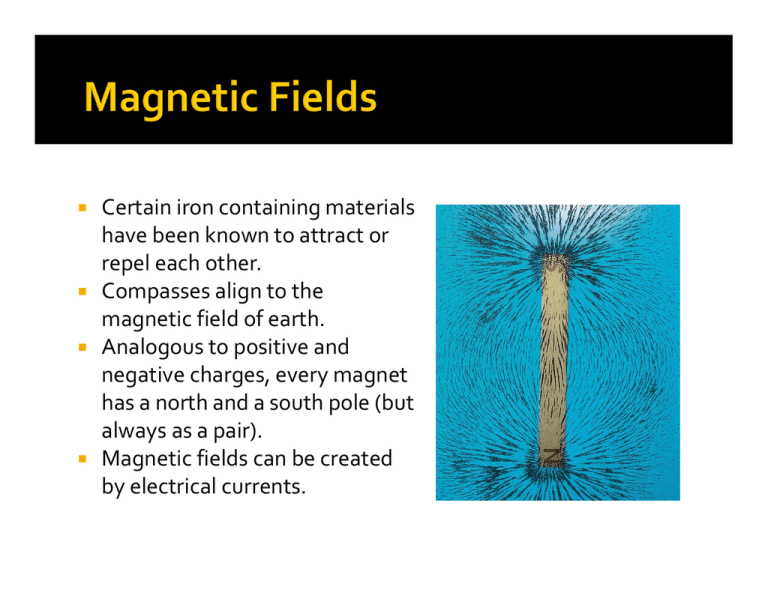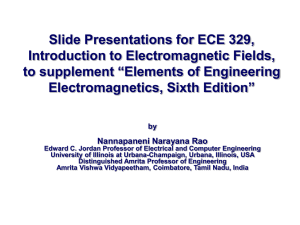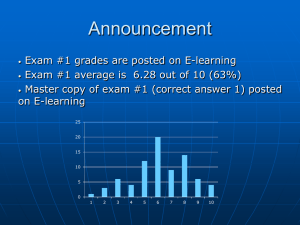Certain iron containing materials have been known to attract or repel each other. Compasses align to the
advertisement

Certain iron containing materials have been known to attract or repel each other. Compasses align to the magnetic field of earth. Analogous to positive and negative charges, every magnet has a north and a south pole (but always as a pair). Magnetic fields can be created by electrical currents. FB FB q, v B +q v v // B FB 0 0 FB B, v FB q 0, v opposite direction FB sin FB q 0, v FB qv B FB q vB sin Magnetic Field, B: Tesla (T)=N/(C.m/s)=N/(A.m) Right Hand Rule Magnetic Field Representation FB qv B FE qE Electric forces act in the direction of the electric field, magnetic forces are perpendicular to the magnetic field. A magnetic force exists only for charges in motion. The magnetic force of a steady magnetic field does no work when displacing a charged particle. The magnetic field can alter the direction of a moving charged particle but not its speed or its kinetic energy. Consider a positive charge moving perpendicular to a magnetic field with an initial velocity, v. The force FB is always at right angles to v and its magnitude is, FB qvB So, as q moves, it will rotate about a circle and FB and v will always be perpendicular. The magnitude of v will always be the same, only its direction will change. To find the radius and frequency of the rotation: The radial force F ma r v2 FB qvB m r r mv qB The angular speed v qB r m The period 2r 2 2m v qB T Cyclotron frequency Electron beam in a magnetic field V = 350 V v V r FB B K U 1 me v 2 eV 2 r = 7.5 cm q = e = 1.6 x 10-19 C m = me = 9.11 x 10-31 kg B=? =? v r mv qB 2eV 1.11107 m / s me B me v 8.4 10 4 T er qB eB 1.5 108 rad / s m me Helical Motion – vx, vy and vz Cosmic Rays in the Van Allen Belt Complex Fields – Magnetic Bottles Essentially it is the total electric and magnetic force acting upon a charge. F qE qv B Velocity Selector Mass Spectrometer Fe FB v E B m rB0 B q E Magnetic force acts upon charges moving in a conductor. The total force on the current is the integral sum of the force on each charge in the current. In turn, the charges transfer the force on to the wire when they collide with the atoms of the wire. FB ,q qv d B FB qv d B nAL I vd qnA FB IL B For a straight wire in a uniform field dFB Id s B b FB I d s B a For an arbitrary wire in an arbitrary field b FB I d s B a b FB I d s B a FB IL B The net magnetic force acting on a curved wire in a uniform magnetic field is the same as that of a straight wire between the same end points. FB I d s B ds 0 FB 0 Net magnetic force acting on any closed current loop in a uniform magnetic field is zero. On the curved wire dF2 I d s B IB sin ds s R ds Rd dF2 IRB sin d 0 0 F2 2 IRB Directed in to the board F2 IRB sin d IRB sin d On the straight wire F1 ILB 2 IRB Directed out of the board F F1 F2 0 If the field is parallel to the plane of the loop LB 0 For 1 and 3, FB 0 For 2 and 4, F2 F4 IaB max max b b b b F2 F4 IaB IaB 2 2 2 2 IaB b max IAB If the field makes an angle with a line perpendicular to the plane of the loop: a a F2 sin F4 sin 2 2 b b IaB sin IaB sin IabB sin 2 2 IAB sin τ IA B A rectangular loop is placed in a uniform magnetic field with the plane of the loop perpendicular to the direction of the field. If a current is made to flow through the loop in the sense shown by the arrows, the field exerts on the loop: 1. a net force. 2. a net torque. 3. a net force and a net torque. 4. neither a net force nor a net torque. μ IA (Amperes.m2) τ μB If the wire makes N loops around A, τ Nμ loop B μ coil B The potential energy of the loop is: U μ B qvd B qE H E H vd B VH vd Bd vd I nqA IB RH IB VH nqt t The right hand rule Magnetic forces on charged particles Charged particle motion Magnetic forces on current carrying wires Torque on loops and magnetic dipole moments Reading Assignment Chapter 30 – Sources of the Magnetic Field WebAssign: Assignment 7





